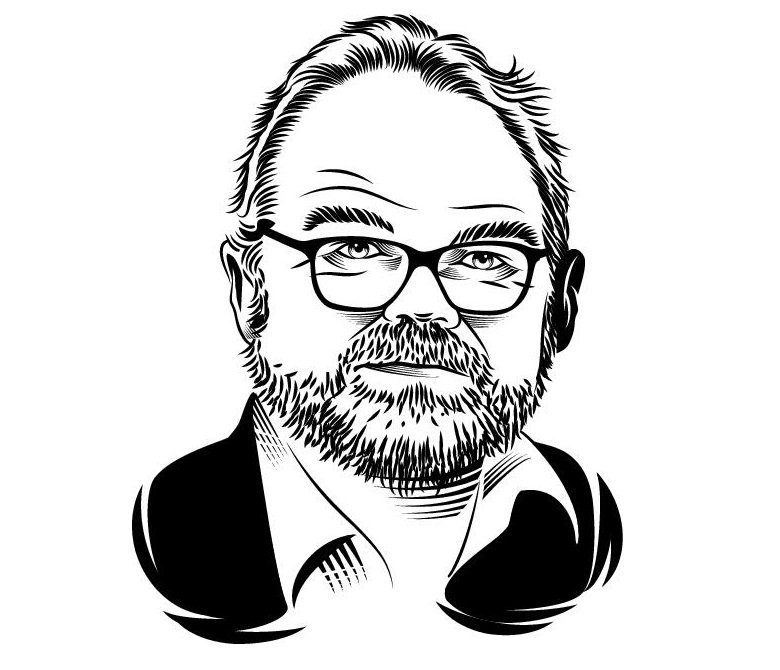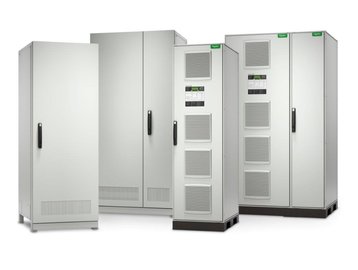The power losses in static-UPS have gradually decreased over the past 20 years. From the early days of thyristor based series on-line (usually referred to as double-conversion or, now, IEC ‘VFI’ meaning voltage and frequency independent) with transformers at the input and output and full-load operating efficiency of 83-85% to transistor (IGBT rectifier and inverter) based line-interactive (VI, voltage independent) transformer-less machines achieving 97.5-98% we have seen a huge improvement;
- Energy efficiency increased by 15% plus a drastic reduction in cooling capacity
- Reliability increased, with a module MTBF rising from <25,000h to >120,000h
- Output voltage waveform improved from >5% to 1% distortion from a sinewave
- Input current harmonics down from 33% to <3%
- Foot-print reduction by a staggering 90%
- Noise, from 95dB(A) to 75dB(A)
Even double-conversion (VFI) has reached 96.8% efficiency but, if all that were not enough, the cost per kW capacity has steadily fallen to its lowest level ever. Good for the purchaser but, unfortunately for the manufacturer, the only way to make a profit from UPS is to provide after-sales-services.
Quo vadis?
So, by 2008, where was there left to go? In Europe, all UPS’s had already become transformer-less, although, because of our 4-wire distribution, this was easier to introduce than it would have been in North America. In fact, transformer-less UPS in North America is available but still a minor novelty and often regarded as somewhat exotic. Of course, with 3-wire 480V distribution our American colleagues still require downstream transformers to connect 120V and 208V loads.
At the same time a move to increased adoption of line-interactive topology (IEC ‘VI’) offered clients energy saving albeit without any frequency protection – not technically ‘on-line’, although sometimes advertised as such, but working well enough in stable grids. So, the idea of ‘eco-mode’, originally introduced by Invertomatic in Switzerland in the 1990s but soon dropped due to lack of sales, was resurrected along with ‘modular’ UPS. Modular UPS overcame partial load inefficiencies, which are endemic in most data centers. However, here we shall concentrate just on eco-mode.
The principle of eco-mode is simple – when the utility is stable the UPS switches itself into bypass operation and the losses reduce, especially in transformer-less designs. The rectifier still floats the battery (only 10’s of Watts needed, unlike flywheels that need more) but the inverter is throttled right back and, in the best designs, the cooling fans are speed reduced to save the last few Watts. The automatic bypass (a thyristor switch) keeps the load on the utility until the utility shows the first sign of deviation – at which point the static switch transfers the load back to the inverter, all in under 4 milliseconds and within the (rather outdated) ITIC/CEBMA PQ Curve, although the best-in-class bypasses with DSP (Digital Signal Processing) control can bypass in 2ms. The UPS then monitors the utility for stability and after a period, usually one hour, switches the load back to bypass.
The advantages are clear; 99% efficiency and, in stable grids, for >95% of the year with the added bonus of excellent low-load efficiency as well. There are some unscrupulous salesmen that mention ‘low-power state’ for the inverter in eco-mode but, make no mistake, the UPS is in bypass with no power quality improvement and the critical load fed by ‘raw mains’. Now, there are some ‘advanced’ eco-modes around that monitor the load distortion and make decisions about the grid being able to accept it with a slight efficiency penalty, but the basic concept remains – if the utility is stable you save energy.
But are there risks? In this world ‘reward’ usually comes with ‘risk’ and eco-mode is no different, so, yes there are tangible risks to enabling eco-mode. Every time the utility deviates the load is switched – the very opposite of the conceptual protection offered by ‘double-conversion’. This switching represents a risk to the load, albeit small and maybe even inconsequential, but the user must balance that risk with the reward. Make no mistake, the reward can be high - with a Return-on-Investment (covering the entire UPS cost) of <2 years.
The result now, in 2017, is a slowly growing acceptance of eco-mode and this will, no doubt, continue as energy costs rise and the concept is proved reliable. However, it is a fact that energy effectiveness is not always the most important metric that users aspire to so there are a few high reliability dual-bus facilities that are hedging their bets by enabling eco-mode in one bus and running VFI in the other, alternating each week or month. However, the risk, whether real or perceived, will remain and limit the adoption of eco-mode but for one future development (which has already started in Japan) could negate any advantage of eco-mode.
Time for Carborundum
Transistors are currently manufactured with layers of doped silicon. The best to date, for UPS, are of the Insulated Gate Bipolar (IGBT) type and these have become increasingly powerful and very reliable. One drawback is that the faster you switch them (to achieve more precision in the voltage waveform) then the higher the losses. This is what contributes to the upper limit of 96.8% module efficiency. However, a change from Silicon based transistors to Silicon Carbide (better known to some as Carborundum or occurring in nature as the extremely rare mineral Moissanite) in the manufacture of semiconductor switches like IGBTs holds the key to >99% UPS module efficiency in double-conversion. Synthetic silicon carbide powder has been mass-produced since 1893 for use as an abrasive e.g. silicon carbide paper for finishing metals, so this is not ‘bleeding edge’ material science.
Silicon Carbide IGBTs cost considerably more (although that is likely to fall as volumes increase) but the energy saving will rapidly be recovered – and all without switching the critical load to the raw utility and increasing risks of transfer. Hence, Silicon Carbide will spell the end of worrying about the enablement of eco-mode and possibly even kill off line-interactive (VI) UPS. Who will need to worry when you can get total protection of voltage and frequency protection with less than 1% losses?
Just last week I was lucky enough to meet a Japanese OEM who already markets 500kVA & 750kVA SiC UPS modules in Japan and the USA and have achieved 99.3% kW:kW efficiency in full double-conversion VFI, with better than 98% at 20% load. To date they don’t extend sales (and, critically, after-sales-service) to Europe but I would suggest that they do so quickly.
Just think about the potential energy saving in a modest 1MW ICT design load. If we assume a typical 60% load and compare with current ‘best-in-class’ VFI UPS products then, at GB£0.1/kWh, the user will save about 263MWh, £26,300, or 100 tonnes of CO2 in the UK utility every year. All with full VFI protection and no decisions or risks to tax the mind.
Ian Bitterlin is a consulting engineer at Critical Facilities Consulting Ltd and a visiting professor to the University of Leeds, School of Mechanical Engineering. He also trains data center staff at DCPRO
This is an updated and expanded version of an article that appeared in the Power Supplement distributed with the Feb/March 2017 issue of DCD magazine



